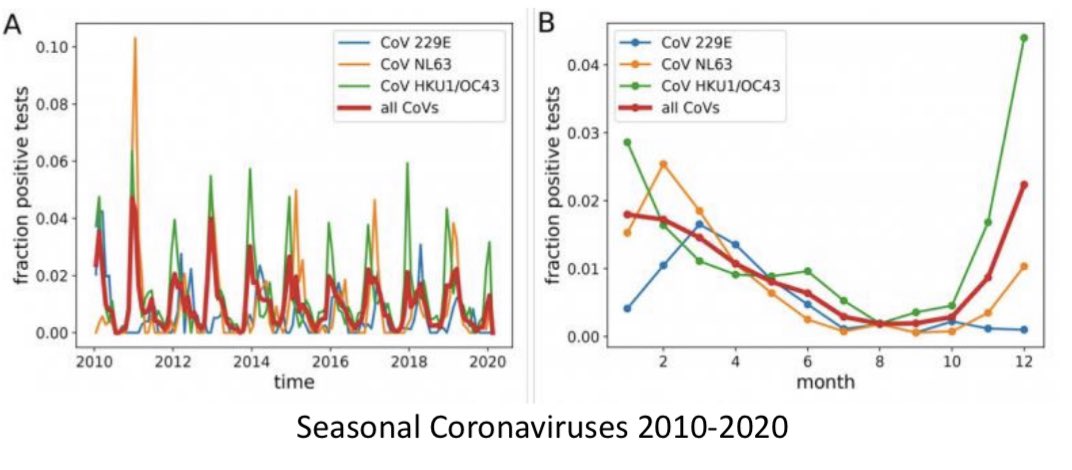
Short thread:
Cases are starting to plummet quickly.
This isn’t from vaccines (yet).
Possible we may be starting see a combination of seasonality on our side and likely seeing herd effects kick in.
1/x
Cases are starting to plummet quickly.
This isn’t from vaccines (yet).
Possible we may be starting see a combination of seasonality on our side and likely seeing herd effects kick in.
1/x

On seasonality:
We knew in the summer that this virus was going to roar back in the fall. It did!
While coronaviruses collectively have a broad window each year, We can see that each individual coronavirus in the graph 👆has only a few months when it peaks. And then drops
2/x
We knew in the summer that this virus was going to roar back in the fall. It did!
While coronaviruses collectively have a broad window each year, We can see that each individual coronavirus in the graph 👆has only a few months when it peaks. And then drops
2/x
This virus started really hitting us hard a second time in November. Oct-Jan may well be this viruses peak transmission window. We could be entering a reprieve from its grasp, at least for a while. If so, could help us get vaccines out and control spread quickly.
3/x
3/x
On herd effects:
At least in the US, we have RECORDED 27 million cases.
I’ve long held there is a very good chance we are undercounting my massive margins. In first wave there is no way we caught near 1 in 10 cases. Possible on average we’ve caught fewer than 1:10 since..
4/x
At least in the US, we have RECORDED 27 million cases.
I’ve long held there is a very good chance we are undercounting my massive margins. In first wave there is no way we caught near 1 in 10 cases. Possible on average we’ve caught fewer than 1:10 since..
4/x
Catching 1 in 10 would put US at 250 million cases occurred. This doesn’t agree with the serologies. But serologies for a first infection are limited. We’ve calibrated assays around sick people since they serve as positive controls... may miss many w low grade infections.
5/x
5/x
This is all speculative. The data and history is limited. But the quickly diminishing cases should be viewed firstly as a good thing and secondly in light of natural effects. I don’t think this is owing to vaccines (it’s just not...yet) nor any massive behavioral change.
6/x
6/x
Possible this is some combo of herd effects from many mild/ asymptomatic infections that went untested (obviously vast majority were not tested) and some benefits of seasonality
For the moment, we need to keep taking this as seriously as possible and see cases approach zero
7/7
For the moment, we need to keep taking this as seriously as possible and see cases approach zero
7/7
I want to clarify that these are some of my thoughts. Not owing to a rigorous analysis.
I do think we need to look to the past (other viruses) to gain insight into this one.
Also, the extra transmission owing to the variants may breakthrough the seasonality.
8/x
I do think we need to look to the past (other viruses) to gain insight into this one.
Also, the extra transmission owing to the variants may breakthrough the seasonality.
8/x
We know from many countries now just how devastatingly fast the new variants have swept through and replaced the original.
This could spell a lot of trouble for us in the near term. We can’t let our guard down now. But rather should have it as high as possible at moment.
9/x
This could spell a lot of trouble for us in the near term. We can’t let our guard down now. But rather should have it as high as possible at moment.
9/x
It’s possible these variants will have unique characteristics that don’t follow seasonal “rules” or could breakthrough pre-existing immunity (from infection or vaccines)
So need to remain vigilant and keep doing what we can to roll out effective mitigation strategies
10/x
So need to remain vigilant and keep doing what we can to roll out effective mitigation strategies
10/x
• • •
Missing some Tweet in this thread? You can try to
force a refresh


